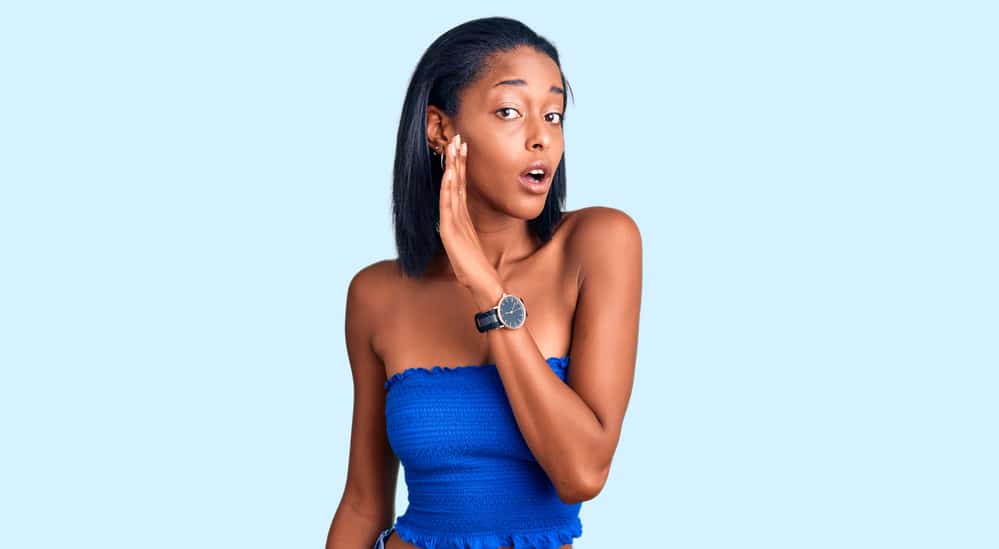What Does Damaged Hair Look Like? Wet? Curly? DIY Remedies

Hair damage is a problem that we all try to avoid, especially when we first go natural. But how can we know if we’re giving our hair sufficient care if we can’t reliably spot damage?
Luckily, hair shows damage on the outside; to catch most types of damage, all you’ve got to do is look at it. In this article, we’ll tell you what damaged hair looks like. That way, you’ll be able to detect damage right as it’s occurring and do something to stop it in its tracks.
Table of Contents
What Does Damaged Hair Look Like?
Your hair speaks to you in several ways, but the most noticeable way is through visible changes. We’d like to start by outlining some of the top visible hair damage signs and what they may mean. Let’s get right into it!
It Looks Dull
Smooth, normal, healthy hair cuticles lie down flat. They catch the light and give the hair a natural shine and vibrance. But when your hair is damaged, it may appear dull and dim.
This often happens due to chemical damage, over-manipulation, or other structural damage to your hair. Each of these culprits can cause your hair cuticles to stand on end instead of lie flat; as a result, the hair doesn’t reflect light like it used to.
If your hair was shiny for years, but nowadays it looks like a shadow has been cast over it, that’s a potential sign of damage.
Note: Another cause of hair dullness is product buildup. If you’ve been using a lot of heavy products lately and haven’t taken the time to deep cleanse your hair with a clarifying shampoo, this could be the culprit.
It Looks Thinner
When your hair is damaged, it may look thinner. The thinning may not be severe, but any thinning could point to a problem with your hair.
Are you noticing more hair in your brush, on your floor, or on your countertops? This could signify increased shedding, which is often associated with damage.
Hair shedding is usually characterized by entire strands of hair falling out at once – not breakage along the hair shaft. Many notice that their hair is shedding more often after they’ve gotten their hair dyed or bleached.
When the damage from chemical processing is extensive, it can cause your hair to fall out at the roots.
When it comes to hair breakage, things are a little bit different. The hair doesn’t fall out at the roots – it breaks off at some point along the hair shaft. Your hair follicles are left intact.
If you’re dealing with breakage, your hair may look uneven, and you may see short pieces of hair falling out as you style or maintain your hair.
The hairs that fall out will not have a bulb at the end. This is a sign that the hair did not come out at the root – it broke off instead.

It’s Thin Only at the Ends
When you look at your hair in the mirror, is it a uniform thickness from roots to ends? If not, it’s probably damaged. The healthiest hair is as thick at the roots as it is at the ends.
But in the case of damaged hair, the ends will be considerably thinner than the hair at the roots. This difference in thickness signals that something is damaging the hair to the point that it’s either breaking or thinning out as it grows.
Usually, the culprit is excessive brushing or combing, hot styling tools, or other damage-inducing hairstyling practices. Thinning ends may also creep up as a result of an inadequate hair maintenance routine (not enough moisturizing or deep conditioning sessions).
It Looks Dry or Like Straw
When your hair is damaged, it’s often more prone to dryness. This damage sign is different from previous signs because hair dryness doesn’t always point to damage.
Sometimes, your hair may be dry just because you skipped a moisturizing session. But if your hair looks dry all the time, it could be that your hair cuticle has been damaged in some way.
Here are some causes of damage that manifest in chronically dry hair:
- Your hair was damaged by heat, which degraded your hair’s cuticles, rendering them unable to hold onto moisture.
- Your hair has been overprocessed with hair dye or bleach. The chemicals have stripped away your hair’s protective layer. Without protection, your hair can no longer retain moisture.
- Your hair has been subjected to heavy sun rays over a long period.
If left unchecked, your hair can progress from dryness to weakness and eventually breakage. So, if your hair seems to be dry all the time, it’s wise to take every step you can to rehydrate it.
The Ends Are Split

Split ends are a hallmark of damaged hair, and they’re easy to spot. In case you’re not aware, a split end occurs when a hair splits apart at some point along the hair shaft.
The most common split end type is the “Y” split, where a hair strand splits into two at the end. But there are several other types of split ends that you should know about:
- Baby split ends – They are barely-there split ends that are much less noticeable than traditional split ends, but you can see them if you look close enough. They are situated at the ends of hair strands and look like a tiny “v.”
- Triple split ends – Triple split ends are hair strands that are split into three sections at the end. This split end type is less common than the “Y” split, but it’s much more severe. It’s also caused by a weakened hair cuticle (often because of heat or a chemical treatment).
- Tree splits – Tree splits are characterized by hair strands that are split in several places, resembling the shape of bare tree limbs. Severe splits like these are typically caused by rough brushing, infrequent trimming, excessive hair coloring, or bleaching.
- Incomplete splits – Incomplete splits are holes in your strands usually resulting from structural damage from rough styling.
Note: This is not a complete list of split end types.
When your hair is split, you’ll notice that it is harder to smooth down. Your ends may stay unruly regardless of how much gel or heat you apply to your hair.
It Looks Unruly
Unruly hair is yet another visible sign of hair damage. Curly hair has a bit of a natural unruliness to it, but if your hair is becoming more and more defiant over time, chances are your hair is damaged. Split ends and damage from relaxers, perms, hair dyes or hair colors cause unruliness in hair.
You May Have Excessive Tangles
Damaged hair also shows up in the form of excessive tangling. It’s normal for your hair to be tangled from time to time, but if the tangling is excessive, there’s reason to be concerned.
When your hair’s cuticles are raised from color damage, increased hair porosity, or any other structural manipulation, strands are more likely to tangle and latch onto each other.
Curly hair tends to tangle quite easily, but if you haven’t changed your hair routine and your hair is more tangled than usual, damage may be to blame.

What Does Damaged Hair Feel Like?
It is also possible to detect damaged hair by touch. Compromised hair often has a rough feel due to a change in cuticle health.
You can determine your hair cuticle’s health by running your fingers down the length of a few of your strands. Healthy hair cuticles are smooth to the touch.
If there are any obvious indentations, rough spots, or splits, chances are your hair is damaged.
When your hair is severely damaged, it may be so undernourished that it’s got virtually no moisture left. So, when you go to scrunch your hair, it may even feel crunchy.
Can Damaged Hair Be Repaired?
After reading about the above damage signs, you may have concluded the worst – that your hair is damaged. If that’s the case, chances are you want to know what you can do about it, if anything.
Though you may come across many products that claim to treat damaged hair, the truth is that damaged hair cannot be repaired. Hair cannot regenerate itself, so once structural damage is done, it can’t be remedied in a meaningful way.
Does Damaged Hair Grow Back Healthy?
Once your hair becomes damaged, you’re not doomed to have unhealthy hair forever. As long as your hair follicles are healthy, they will continue to produce hair.
This means that your primary concern should be how you treat your hair as it grows.
How to Remedy Hair Damage
Though you can’t restore damaged hair to its previous state, your hands aren’t tied. You can take steps to improve the look of your damaged hair and prevent it from getting worse, and that’s what we’ll address in this section:
- Olaplex – Though experts emphatically state that you can’t repair hair after it’s been damaged, Olaplex begs to differ. The makers of the Olaplex hair renewal system state that their proprietary product has the power to repair damaged hair. They use molecular science to restore the hair’s protein bonds. While many have used Olaplex to protect their hair from damage during the dyeing process or restore their chemically damaged hair, there are limitations to what the system can do. For instance, it cannot repair active split ends.
- Cut off the damage – Giving your hair a clean slate is one of the best things you can do on your hair restoration journey. This is especially necessary if you have split ends. If your hair’s structure has been damaged (split ends, heat damage, chemical burns, etc.), the only thing you can do is start over and baby your hair going forward. Sometimes all you need is a trim (¼ to ½ of an inch) to set you on the right track, but other times, you’ll need an extensive trim (more than ½ inch). The amount of damage you have will determine how much you’ll need to cut off.
- Beef up your deep conditioning routine – A good deep conditioning session can increase your hair’s moisture and protein levels. When you have optimal protein and moisture levels, your hair will be less likely to break during styling, and it’ll require less zhushing since it’ll be more manageable. Not to mention the fact that well-moisturized, healthy hair always looks better than dry, damaged hair.
- Wash your hair gently. Gentle washing requires you to use the right products and scrubbing technique. Whenever you wash your hair with rough products, like shampoos laden in sulfates, your hair can end up parched. That makes it much more likely to incur structural damage. So, we encourage you to use a sulfate-free shampoo; it will still get your hair clean, but it’ll do so without leaving your hair super dry. Secondly, always be gentle with your strands while washing them. Wet hair is much more fragile than dry hair, and if you are rough with your strands while they’re wet, damage won’t be far behind.

Best Products for Preventing Hair Damage
Since you can’t heal damaged hair, your best bet is to cut off the damage and then give your hair some TLC.
And one of the best ways to baby your hair is to build up your anti-damage product stash. Fill your product stash with products geared to give your hair a real boost.
Here, we’d like to highlight some fantastic products you can pick up right now to give your hair the care it needs:
- Living Proof Restore Shampoo – This is an ultra-gentle shampoo that’ll remove impurities, excess oil, and debris from the hair while preserving its moisture levels. It is sulfate-free, paraben-free, cruelty-free, and color-safe. The formula was created specifically for people with damaged hair. Use it up to twice a week to keep buildup and excess oils at bay.
- SheaMoisture Miracle Multi-benefit Conditioner – This conditioner by SheaMoisture is infused with meadowfoam and sugarcane extract. The meadowfoam injects moisture, and the sugarcane extract coats, smooths, and protects dry hair. It’s also got marshmallow root, which aids in detangling. Together, these ingredients and more take your conditioning sessions up a notch and leave your hair feeling smooth and luxurious. Use this conditioner after shampooing your hair to rehydrate it and make detangling sessions a breeze.
- RENPURE Coconut Whipped Creme Leave-in Conditioner – This leave-in conditioner features coconut extract, argan oil, and more to give the hair a substantial dose of moisture. It penetrates the hair cuticles to deliver lasting nourishment to your strands. Feel free to use this leave-in between wash days whenever your hair feels like it needs a pick-me-up.
- Macadamia Natural Oil Deep Repair Masque – This deep conditioner does wonders for damaged hair. With a winning formula that features macadamia oil, it’s poised to transform your hair in a hurry. It also features vitamin E and green tea extract. Use it once or twice a week on wash days to soften and strengthen damaged strands.
- Olaplex Hair Perfector No. 3 Repairing Treatment – This treatment by Olaplex promises to bring your hair from the brink of ruin. It repairs your hair’s protein bonds for stronger strands. Some notice that their hair appears less damaged after use. Use it two to three times weekly to reap the benefits.
Adding these products to your collection will reduce your chances of developing hair damage and breakage.
When To See a Professional

There will be times when your hair care methods aren’t working, and you need a professional opinion. Here are some situations that signal you may need some outside help with your hair:
- Your hair is falling out in clumps, and you have no idea how to stop it. Hair loss could be caused by hormonal changes, stress, and more. If you suspect that your hair loss is due to a medical issue and not questionable hair care habits, we recommend that you see your primary care doctor. They may refer you to a dermatologist for further evaluation.
- Your hair is split up to your roots, and you haven’t seen any improvement in your hair after giving up damaging hair care habits and processes. Sometimes, the only solution is to cut your hair off completely, but before you do so, it’s wise to see a local cosmetologist and make sure it’s necessary.
- You don’t have time to figure out or remedy what’s going on with your hair. Figuring out your hair issues and fixing them will take some time and effort. If you don’t have that, you won’t get the results you desire. In that case, you should reach out to a cosmetologist in your area.
- Does Toner Damage Hair Like Bleach?
- Can Bleaching Your Hair Ruin It Forever?
- How To Know if My Hair Is Heat Damaged
- Do Perms Ruin Your Hair Forever?
To sum things up, we’ve determined that your natural hair may look dull, dry, unruly, split, or thin if it’s damaged.
Once you notice these signs, it’s time to make some changes to your hair care routine. And the earlier you do something about hair damage, the better. We encourage you to use the tips and suggestions outlined in this article to revive your hair.







